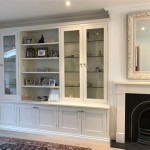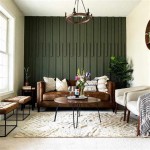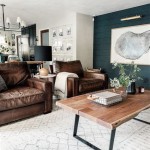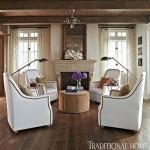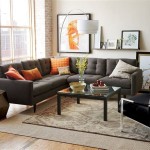Living Room Wall Mirror Ideas: Enhancing Space and Style
Mirrors, often relegated to bathrooms and bedrooms, are increasingly recognized as powerful design tools for living rooms. A strategically placed mirror can transform a space, amplifying light, creating an illusion of greater size, and serving as a focal point. The selection and placement of a living room wall mirror require careful consideration of the room's architecture, existing décor, and desired aesthetic. This article explores various living room wall mirror ideas, providing guidance on how to effectively integrate mirrors into your living space.
Maximizing Natural Light with Mirror Placement
One of the primary benefits of incorporating mirrors into a living room is their ability to enhance natural light. Mirrors reflect and redistribute sunlight, brightening dark corners and reducing reliance on artificial lighting. To maximize this effect, position the mirror opposite or adjacent to a window. This placement captures the incoming light and bounces it back into the room, effectively doubling the amount of illumination. The size of the mirror is also a crucial factor; a larger mirror will reflect more light than a smaller one.
The type of window and its location play a significant role in determining the optimal mirror placement. For example, a window facing south receives direct sunlight for a large part of the day. Positioning a mirror opposite this window can flood the room with warm, natural light. Conversely, a window facing north receives softer, indirect light, which can be enhanced by a mirror positioned to capture and diffuse it evenly throughout the space. Consider the angle of the sun's rays at different times of the day to ensure the mirror effectively reflects light without creating glare.
Beyond direct sunlight, mirrors can also reflect ambient light from other sources, such as lamps or overhead fixtures. Experiment with different mirror positions to identify the configurations that best enhance the overall brightness of the room. In smaller living rooms with limited natural light, using multiple mirrors strategically can create a brighter and more inviting atmosphere.
Creating the Illusion of Space with Mirror Design
In addition to maximizing light, mirrors can significantly impact the perceived size of a room. A well-placed mirror can create the illusion of depth and expansion, making a small living room feel more spacious and airy. This effect is achieved by reflecting the existing space, effectively doubling the visual dimensions of the room. The size and shape of the mirror, as well as its framing, contribute to the overall impact on spatial perception.
A large, full-length mirror placed on a wall can create the most dramatic effect, making the room appear significantly larger. This is particularly effective in narrow living rooms where the mirror can visually widen the space. Alternatively, a series of smaller mirrors arranged in a grid pattern can also create a sense of depth and visual interest. When using multiple mirrors, ensure they are evenly spaced and aligned to maintain a cohesive and balanced look. The frames of the mirrors can be consistent or varied, depending on the desired aesthetic.
The reflections captured by the mirror are crucial to creating a successful illusion of space. Avoid placing the mirror in a position where it reflects clutter or unsightly objects. Instead, strategically position it to reflect an open area, such as a doorway or a view of the outdoors. This will enhance the sense of spaciousness and create a more inviting atmosphere. Also, consider the height at which the mirror is mounted. A mirror mounted too low may not effectively capture and reflect the desired space, while a mirror mounted too high may feel disproportionate to the room's scale.
Selecting the Right Mirror Style and Frame
The style and frame of a living room wall mirror should complement the existing décor and reflect the overall aesthetic of the space. Mirrors come in a wide variety of shapes, sizes, and styles, ranging from ornate and traditional to sleek and modern. The frame of the mirror can significantly impact its visual presence and should be carefully chosen to harmonize with the room's existing design elements.
For traditional living rooms, consider mirrors with ornate frames made of wood or metal. These frames often feature intricate carvings or embellishments that add a touch of elegance and sophistication to the space. Antique mirrors with distressed finishes can also complement traditional décor, adding a sense of history and character. In contrast, modern living rooms often benefit from mirrors with clean lines and minimalist frames. Metal frames, such as those made of chrome or stainless steel, can create a sleek and contemporary look. Frameless mirrors are also a popular choice for modern spaces, offering a clean and understated aesthetic.
The shape of the mirror should also be considered in relation to the room's architecture and furniture arrangement. Rectangular mirrors are a versatile choice that can be used in a variety of settings. They are particularly effective when placed horizontally above a sofa or console table, creating a sense of balance and symmetry. Round or oval mirrors can add a softer touch to the room, and they are often used as focal points above fireplaces or in entryways. Irregularly shaped mirrors can create a more eclectic and artistic look, adding a unique and personal touch to the space.
The size of the mirror frame should be proportional to the size of the mirror itself and the surrounding wall space. A frame that is too large can overwhelm the mirror and make it appear disproportionate. Conversely, a frame that is too small may not provide enough visual interest or support. Consider the color and texture of the frame in relation to the other elements in the room, such as the walls, furniture, and accessories. A contrasting frame can create a bold statement, while a frame that blends in with the surroundings can create a more subtle and cohesive look.
The materials used in the mirror and frame should also be durable and suitable for the living room environment. Mirrors are often made of glass, which can be prone to damage if not handled carefully. Choose a mirror with a high-quality coating that is resistant to scratches and smudges. The frame should also be made of durable materials that can withstand the wear and tear of everyday use. Wood frames should be properly sealed and finished to protect them from moisture and damage. Metal frames should be made of rust-resistant materials to prevent corrosion.
Finally, consider the cost of the mirror and frame in relation to your budget. Mirrors can range in price from relatively inexpensive to quite expensive, depending on the size, style, and materials used. Shop around and compare prices to find the best value for your money. Remember that a well-chosen mirror can significantly enhance the look and feel of your living room, so it is worth investing in a high-quality piece that you will enjoy for years to come.
By carefully considering these factors, you can select a living room wall mirror that not only enhances the space but also reflects your personal style and taste.

7 Stunning Feature Wall Ideas For Your Living Room Mirror Decor

Living Room Wall Decor Ideas How To Display Art Mirror Designs

Mirror Decoration Ideas For Living Room Doğtaş

How To Decorate With Mirrors Decorating Ideas For

5 Decorative Wall Mirrors For Your Home Designcafe

Image Gallery Page 426153183488350696 Artofit Interior Wall Design Hall Decor Living Room

Mirror Decoration For Home 15 Ideas To Decorate With Mirrors

Wall Mirror Design Ideas For Your Home Cafe

Wall Mirror Decor Ideas For A Glamorous Interior

Top 10 Wall Mirror Designs For Your Living Room


